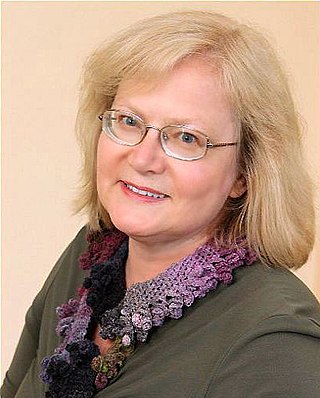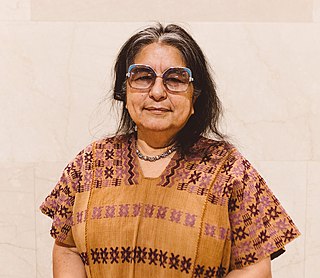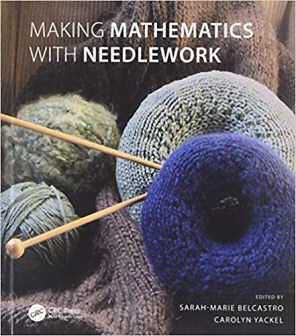Related Research Articles
Crochet is a process of creating textiles by using a crochet hook to interlock loops of yarn, thread, or strands of other materials. The name is derived from the French term croc, which means 'hook'. Hooks can be made from a variety of materials, such as metal, wood, bamboo, bone or even plastic. The key difference between crochet and knitting, beyond the implements used for their production, is that each stitch in crochet is completed before the next one is begun, while knitting keeps many stitches open at a time. Some variant forms of crochet, such as Tunisian crochet and broomstick lace, do keep multiple crochet stitches open at a time.

Daina Taimiņa is a Latvian mathematician, retired adjunct associate professor of mathematics at Cornell University, known for developing a way of modeling hyperbolic geometry with crocheted objects.

In geometry, the rhombille tiling, also known as tumbling blocks, reversible cubes, or the dice lattice, is a tessellation of identical 60° rhombi on the Euclidean plane. Each rhombus has two 60° and two 120° angles; rhombi with this shape are sometimes also called diamonds. Sets of three rhombi meet at their 120° angles, and sets of six rhombi meet at their 60° angles.

Ideas from mathematics have been used as inspiration for fiber arts including quilt making, knitting, cross-stitch, crochet, embroidery and weaving. A wide range of mathematical concepts have been used as inspiration including topology, graph theory, number theory and algebra. Some techniques such as counted-thread embroidery are naturally geometrical; other kinds of textile provide a ready means for the colorful physical expression of mathematical concepts.
Sewing is the craft of fastening or attaching objects using stitches made with needle and thread. Sewing is one of the oldest of the textile arts, arising in the Paleolithic Era. Although usually associated with clothing and household linens, sewing is used in a variety of crafts and industries, including shoemaking, upholstery, sailmaking, bookbinding and the manufacturing of some kinds of sporting goods. Sewing is the fundamental process underlying a variety of textile arts and crafts, including embroidery, tapestry, quilting, appliqué and patchwork.

Anna Miller Corbell (1896–1993) was an early 20th century American artist, known for her panoramic landscape paintings of the American Southwest. Corbell was active as a painter for over thirty years. Her subject matter largely consisted of the Southwestern desert with mountain views. Describing herself as "not a modern painter," she worked in a palette of pastel hues to capture the colors and light of the Arizona desert.
Sabrina Gschwandtner is an American artist currently living in Los Angeles, California. She has held numerous showings of her work throughout the country and several pieces have been acquired by museums, including LACMA, the Smithsonian American Art Museum, the Museum of Fine Arts, Boston, and the RISD Museum.
Martha Cole is a Canadian artist. She is known for her work with textiles, landscape, and artist's books, addressing themes of inter-contentedness, sustainability, and protection of ecological diversity. She currently resides in Disley, Saskatchewan. Cole's high school art teacher, Helmut Becker encouraged her to pursue a career in art. She was an instructor in the Extension Division, Fine Arts and Humanities, University of Regina.
Gwendolyn (Gwen) Ann Magee was an African-American fiber artist. Learning to quilt in the middle of her life, Magee quickly became known in the world of fiber art for her abstract and narrative quilts depicting the African-American experience. Her work can be found in the permanent collections of the Mississippi Museum of Art, the Museum of Mississippi History, the Michigan State University Museum, and the Renwick Gallery of the Smithsonian Museum of American Art, and has been exhibited internationally.
Irena Swanson is an American mathematician specializing in commutative algebra. She is head of the Purdue University Department of Mathematics since 2020. She was a professor of mathematics at Reed College from 2005 to 2020.

The Tempestry Project is a collaborative fiber arts project that presents global warming data in visual form through knitted or crocheted artwork. The project is part of a larger "data art" movement and the developing field of climate change art, which seeks to exploit the human tendency to value personal experience over data by creating accessible experiential representations of the data.

Consuelo Jiménez Underwood is an American fiber artist, known for her pieces that focus on immigration issues. She is an indigenous Chicana currently based in Cupertino, California. As an artist she works with textiles in attempt to unify her American roots with her Mexican Indigenous ones, along with trying to convey the same for other multicultural people.
Margaret Wood is a Navajo-Seminole fiber artist, fashion designer, and quilt maker. Though she began her career as a teacher and librarian, Wood switched to fiber arts to allow her to express her creativity. She published Native American Fashion: Modern Adaptations of Traditional Designs, which for four decades was the only book focused on traditional native clothing and how it was modified in contemporary design. From 1990, Wood primarily became a quilter, displaying her works at numerous featured exhibitions throughout the United States, including such venues as the American Craft Museum in Manhattan; the Heard Museum of Phoenix, Arizona; the Riverside Metropolitan Museum of Riverside, California and the Wheelwright Museum of the American Indian of Santa Fe, New Mexico, among many others.

Making Mathematics with Needlework: Ten Papers and Ten Projects is an edited volume on mathematics and fiber arts. It was edited by Sarah-Marie Belcastro and Carolyn Yackel, and published in 2008 by A K Peters, based on a meeting held in 2005 in Atlanta by the American Mathematical Society.
Susan Goldstine is an American mathematician active in mathematics and fiber arts. She is a professor of mathematics at St. Mary's College of Maryland, and the Steven Muller Distinguished Professor in the Sciences at St. Mary's College.
Elizabeth Whiteley is an American fine artist and designer.
Carolyn Crump is an American quilting artist whose work focuses on African American culture. Her work is included in the collections of the Smithsonian American Art Museum and the Michigan State University African American Quilt Collection.
Sarah-Marie Belcastro is an American mathematician and book author. She is an instructor at the Art of Problem Solving Online School and is the director of Bryn Mawr's residential summer program MathILy. Although her doctoral research was in algebraic geometry, she has also worked extensively in topological graph theory. She is known for and has written extensively about mathematical knitting, and has co-edited three books on fiber mathematics. She herself exclusively uses the form "sarah-marie belcastro".

Mathemalchemy is a traveling art installation dedicated to a celebration of the intersection of art and mathematics. It is a collaborative work led by Duke University mathematician Ingrid Daubechies and fiber artist Dominique Ehrmann. The cross-disciplinary team of 24 people, who collectively built the installation during the calendar years 2020 and 2021, includes artists, mathematicians, and craftspeople who employed a wide variety of materials to illustrate, amuse, and educate the public on the wonders, mystery, and beauty of mathematics. Including the core team of 24, about 70 people contributed in some way to the realization of Mathemalchemy.

Erna Beth Seecamp Yackel was an American college professor and math educator. She was a member of the faculty at Purdue University Northwest from 1984 to 2004.
References
- ↑ Dr. Carolyn Yackel: Professor of Mathematics Mercer University, 2021
- ↑ "In Memoriam: Erna Beth Yackel, 1939–2022". Women In Academia Report. 2022-09-14. Retrieved 2022-12-10.
- ↑ Mathematical Art Galleries: Carolyn Yackel Bridges Conference, Joint Mathematics Meetings
- ↑ "Gathering 4 Gardner: Board of directors". gathering4gardner.org. Retrieved 2022-09-14.
- ↑ Mathematical Art Galleries: Carolyn Yackel Bridges Conference
- ↑ Carolyn A. Yackel at the Mathematics Genealogy Project
- ↑ Mathemalchemy’s Team
- 1 2 "Carolyn Yackel – Google Scholar". scholar.google.com. Retrieved 2021-09-15.